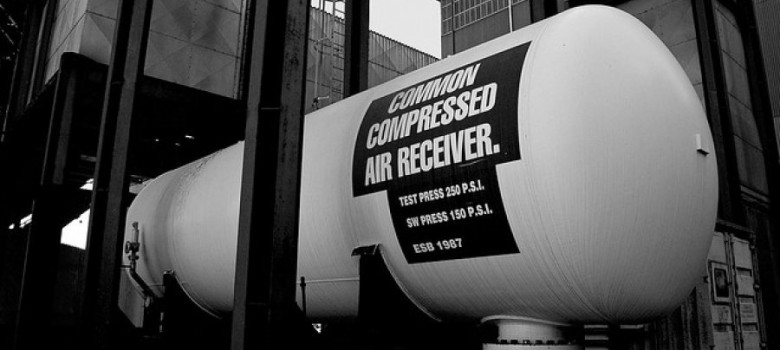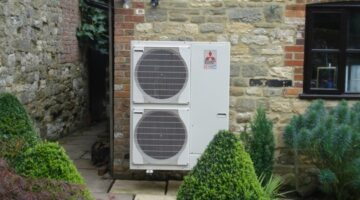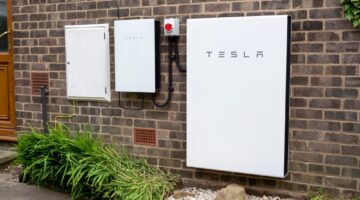
What is compressed air energy storage?
The purpose of compressed air energy storage is to help manage the supply of electricity in the grid. For example when the wind blows a wind turbine will produce power, but this power may be produced when there is no demand for it. At this time it becomes necessary for us to be able to store the electricity, so we can use it when there is a peak in demand. Compressed air energy storage is the second biggest form of energy storage currently behind pumped storage.
Compressed air energy storage involves converting electrical energy into high-pressure compressed air that can be released at a later time to drive a turbine generator to produce electricity. This means it can work along side technologies such as wind turbines to provide and store electricity 24/7. Ideally the compressed air is stored in an existing geographical formation such as a disused hard-rock or salt mine (keeps cost down), rather than producing specialist surface piping, which can be expensive.
How does compressed air energy storage work?
The first compressed air energy storage facility was the E.ON-Kraftwerk’s
290MW plant built in Huntorf, Germany in 1978. This plant was built to help manage grid loads, by storing the electricity as pressurised air when demand was low during the night. When there was peak demand, the compressed air was released to create the electricity, in an effort to lower peak electricity costs.
This plant, which is still maintained as a power back-up installation today, compresses air during times of low demand and stores it in two underground salt caverns. It takes 8 hours to fill both of the caverns at a rate of 108 kg / sec. When electricity is needed, the compressed air is released and heated by combusting natural gas to get the air to expand. This drives a 320MW turbine producing electricity for 2 hours, before the caverns need to be refilled.
Most other compressed air energy storage plants operate along the same principle, although to increase efficiency they are more focussed on retaining the heat associated with compression, which is discussed below.
Increasing the efficiency of compressed air energy storage
One of the major issues with compressed air energy storage is that when you compress air it heats up. When the electricity is required it needs to be expanded, which requires heat. In addition the cooler the air, the more you can store. Companies are therefore trying to find ways to best store the heat generated during compression, so it can then be used to heat the air for the expansion helping drive more efficiency in the overall process.
There are three types of solutions that can deal with heat build up when the air is initially compressed and are discussed below:
- Adiabatic storage – retains the heat from compression and re-uses this when the air is expanded to produce the power – expected efficiency around 70% (although theoretically 100%)
- Diabetic storage – takes the heat and dissipates it into the atmosphere via heat intercoolers. When the air is released to go through the turbines it needs to be heated – expected efficiency around 70%.
- Isothermal storage – involves using heat exchangers to try to always keep the internal and external temperatures the same, so as the air is compressed heat dissipates into the atmosphere. Once the air is released to drive the turbine and produce the electricity, heat is bought in from the external environment.
New technology is being developed by companies to try and increase the heat retained from the compression process. For example, SustainX from the USA have working on a process to remove the heat by injecting water vapour into the compressed air. The water absorbs the heat which then gets stored and reapplied to the air during the expansion process.
Keeping the pressure up
One of the final issues to overcome for successful CAES revolves around the pressure of the compressed air as it comes out. If the storage facility is full of compressed air, the cavern pressure is higher. Visa versa if cavern is almost empty then the cavern pressure will be low. Therefore there are two operating modes when storing compressed air in a fixed volume cavern, which are demonstrated in detail below:
- Allow the pressure to change naturally as the air is released, which will mean the turbine creates less electricity as time goes on.
- Control the flow of air out of the cavern, so it releases more of the compressed air at the end to counter the lower pressure. This will ensure constant electricity supply from the turbine / generator.
The latter option is normally used, despite ‘throttling loses’ (the speed at which the air is released from the cavern). This is so there is always a constant store of air driving the turbine, so you can accurately reflect the amount of electricity that the compressed air energy storage facility will be producing.
The future of compressed air energy storage
In the UK, Seamus Garvey, a professor of Dynamics at Nottingham University, is looking at using deep ocean bags known as ‘energy bags’ to fulfil the role of the natural cavities that are used at the moment. The deep water acts as the pressure vessel, and no matter how full the energy bags are, energy should always be the same. In terms of energy storage, Garvey says that with this proposed technology the cost per unit of energy stored is in the order of £1-£10 / kWh, where as comparators such as pumped storage come in at £50 / kWh and electrochemical stores are about £500 / kWh, therefore make this solution very attractive.
It is expected that the UK will need to be able to store about 200GWh of electricity by 2020, to help support the grid that becomes more dependant on intermittent renewable energy sources. Compressed air energy storage could be a valuable tool in allowing us to hit these ambitious targets.












How much would said compressed air energy storage tanks cost each?
Is it possible to have an Air Motor deliver an output power which is more than the power of the Air Compressor delivering that compressed air to feed the Air Motor?
Only if you add extra heat to the air as you expand it ie expand it hotter than you compressed it. LIke in an internal combustion engine it only works if you put fuel in an d heat the compressed air before (or as) it expands.
from when is this article?
Hi Hilda,
This article was originally posted on Apr 30, 2013 🙂
Thank you!
Harriet
For well over 30 years I have been unfortunately just talking about this. If you don’t throw away the heat of compression, why would this not be close to 100% efficient. Obviously there are some frictional losses [with some heat] in the compressing and decompression process but the “experts” were never able to explain why using the heat would not greatly increase efficiency.
I asked many experts, if you are right then where does this lost energy go if the heat is retained? All I got were blank stares like deer in a a headlight.
How about including information on underwater compressed energy storage
what about liquid air energy storage? It seem like it would take up less space and be more efficient?
It is extremely surprising, to be polite, that this article is un-dated.
Here we are in 2022, soon 2023, and Michaux has pointed out severe problems with the official renewable-electric future.
We could have sorted this out after the period ~1975-85 when we first began taking energy efficiency and renewables seriously. Instead, the North Sea and Alaskan oil fields were turned up to full capacity and politicians actually told voters to stop worrying.
Dennis Meadows, of Limits to Growth fame, now forecasts societal collapse. These are sad times.